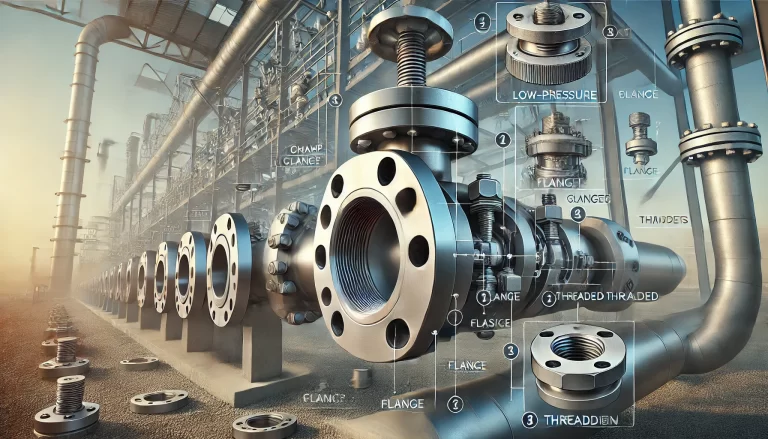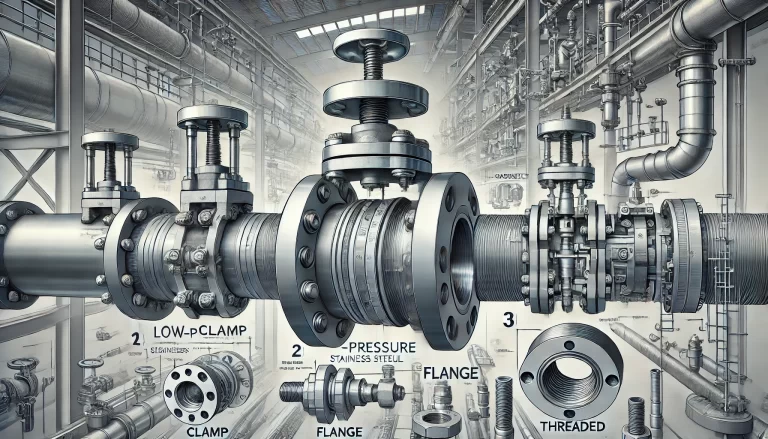In the construction and maintenance of pipe systems, selecting the appropriate connection method is critical. Different connection methods offer unique features, advantages, and limitations, making them suitable for specific applications. Common pipe connection methods include clamp, flange, and threaded connections. This article provides a detailed comparison of these methods, discussing their principles, benefits, drawbacks, and suitable use cases to help engineers and professionals make informed decisions.
Clamp Connections
Clamp connections use metal clamps or couplings to securely join two pipe sections. These clamps are typically fastened with bolts to ensure a tight seal. This method is widely used in low-pressure pipe systems, sanitary pipelines, and liquid transport applications.
Advantages:
Ease of Installation: Clamp connections are simple to install and do not require specialized tools, enabling rapid assembly.
Convenient Maintenance: They allow for quick disassembly, making them ideal for pipe systems that require frequent maintenance or replacement.
Versatility: They can connect pipes of different sizes and materials, offering high flexibility.
No Welding Required: Unlike flange connections, clamps eliminate the need for welding, reducing the complexity and potential risks of installation.
Disadvantages:
Limited Sealing Capability: The sealing relies on elastic gaskets, which may degrade over time or under high-pressure and high-temperature conditions, leading to leaks.
Lower Pressure Tolerance: Clamp connections are not suitable for high-pressure systems as their structural integrity is limited compared to other methods.
Typical Applications: Clamp connections are frequently used in industries such as food processing, pharmaceuticals, and chemical manufacturing, particularly for low-pressure pipe systems or systems that need regular cleaning and disassembly.

Flange Connections
Flange connections involve the use of flange plates and gaskets, joined together with bolts, often requiring welding or other auxiliary fastening methods. Flanges are commonly found in medium- and high-pressure environments, especially in sectors such as oil, gas, chemical processing, and power generation.
Advantages:
High Strength and Pressure Resistance: Flange connections can withstand high pressures and temperatures, making them suitable for demanding environments.
Excellent Sealing Performance: Flanges achieve effective sealing through gaskets, which can be customized to meet specific operational needs (e.g., high temperature or chemical resistance).
Reliability: Their robust structure ensures a stable and long-lasting connection, capable of supporting heavy equipment.
Disadvantages:
Complex Installation Process: Installing flange connections requires precise alignment, tightening bolts, and often welding, which makes the process time-consuming and labor-intensive.
Higher Cost: Flange connections involve additional components such as gaskets and bolts, increasing material and labor costs.
Space Constraints: Flanges require sufficient space for installation and maintenance, which can be challenging in confined environments.
Typical Applications: Flange connections are commonly used in high-pressure, high-temperature systems, such as oil pipelines, chemical reactors, steam systems, and power plant infrastructure. They are also employed for connecting large equipment like pumps, valves, and heat exchangers.
Threaded Connections
Threaded connections use matching male (external) and female (internal) threads to connect pipes. This method is primarily used in low-pressure, small-diameter pipe systems, such as residential plumbing and gas pipelines.
Advantages:
Easy Installation: Threaded connections are straightforward to assemble by simply screwing the components together, requiring minimal tools.
Good Sealing Performance: With the use of sealing tape or thread sealant, threaded connections can provide a reliable seal.
Cost-Effective: They are relatively inexpensive and widely available for small-scale applications.
Disadvantages:
Limited Pressure Capability: Threaded connections are not suitable for high-pressure or large-diameter pipes due to their weaker structural integrity.
Wear and Tear: Threads may wear out with frequent disassembly or prolonged use, compromising the seal.
Restricted Applications: Their use is typically confined to low-pressure, small-scale systems.
Typical Applications: Threaded connections are widely used in residential water supply, gas distribution, and small-scale industrial systems, especially where low-pressure and low-maintenance conditions apply.

Choosing the Right Connection Method
Selecting the appropriate pipe connection method depends on several factors:
Operating Pressure and Temperature: High-pressure, high-temperature systems typically require flange connections.
Maintenance Requirements: Clamp connections are ideal for systems requiring frequent disassembly or cleaning.
Pipe Size: Threaded connections are suitable for small-diameter pipes, while flanges can handle larger pipes.
Cost Considerations: Threaded and clamp connections are more economical for low-pressure systems, whereas flanges are better for demanding applications despite higher costs.
Environmental Conditions: Corrosive or extreme environments may require specific materials and sealing methods, influencing the choice of connection.
By carefully evaluating these factors, professionals can ensure the safety, reliability, and efficiency of their pipe systems.
This detailed comparison provides a comprehensive understanding of clamp, flange, and threaded connections. Each method has distinct advantages and limitations, making them suitable for specific scenarios. Understanding these differences allows for better decision-making in designing and maintaining pipe systems, ultimately improving system performance and longevity.
